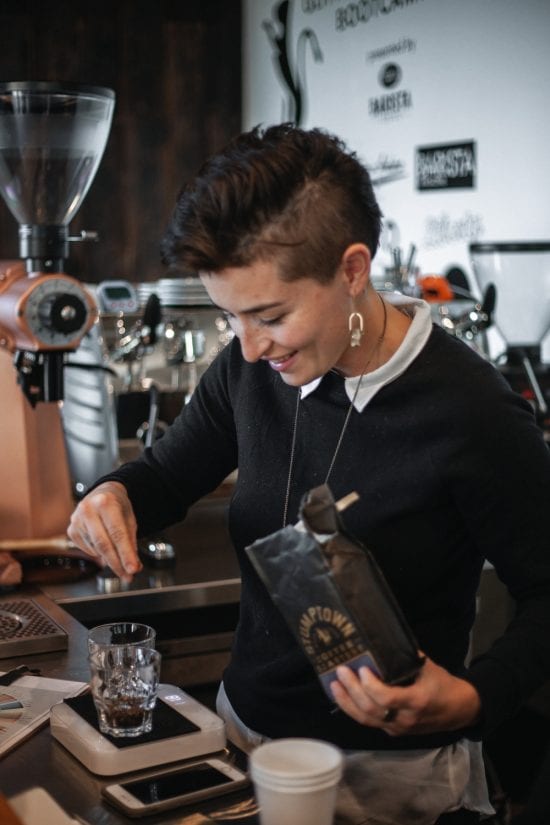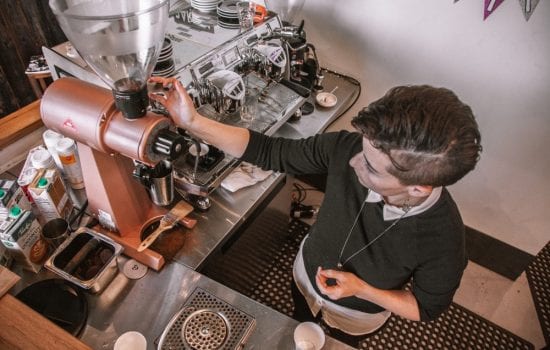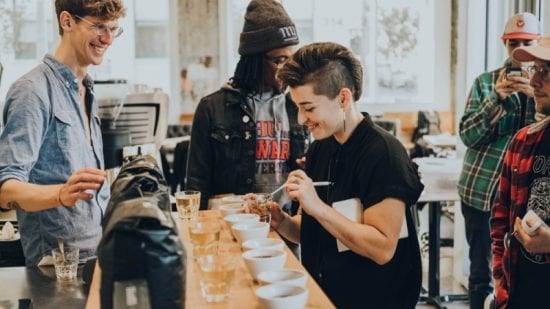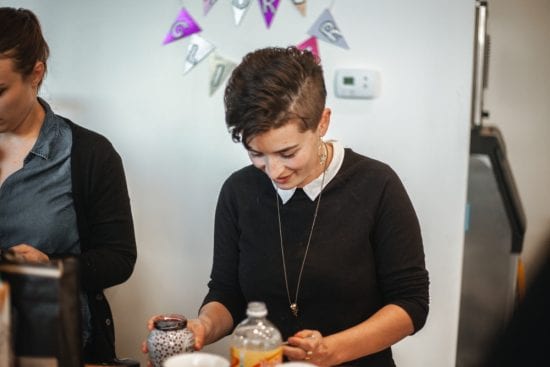
Learn the tips, tricks, and skills that CoffeeChamps Denver third-place finisher Emily Orendorff picked up at the inaugural Glitter Cat Barista Bootcamp.
BY ASHLEY RODRIGUEZ
BARISTA MAGAZINE ONLINE
Cover photo by Roosevelt Nguyen
In October, the inaugural Glitter Cat Barista Bootcamp took place in Philadelphia. The all-expenses-paid training camp brought together baristas from across the nation to learn from past barista champions about how to be successful on stage.
Many of the Glitter Cat trainees will be competing at the upcoming Nashville CoffeeChamps competition—but some folks already took the stage in Denver this past December. One of those people, Emily Orendorff, placed third in the competition and was one of the 10 Glitter Cat trainees. Below, she shares some of the things she learned along the way and gives advice on how you can improve your next barista competition routine.
Hook your judges. “Whatever message you want to convey to your judges for the entirety of your routine, do it in a way that is concise and commanding of your judges’ attention,” Emily shares. “Look them in the eyes one by one, move with intention, and know that they are here to listen to what you have to say.”

In Emily’s routine, this translated to an immediate connection. Right at the beginning of her routine, she referred to herself and the judges as “we” and asked them questions about their coffee careers and motivators that got them thinking immediately. Through that, she was able to build a connection and keep her judges engaged.
Don’t fear the blend! Traditionally, most barista competitors focus on showcasing a coffee from a single place—not just from one country, but from one farm, on one plot of land, and one varietal. Emily encourages folks to think outside of that. “On selecting competition coffee, maybe you have a coffee on your cupping table that has just what you’re looking for in body or mouthfeel, but you have another coffee that you are loving the acidity of but it might be lacking in something else. In a completely unscientific way, don’t be afraid to mix a spoonful of one coffee and two of the other and get weird with it!”
Not every blend needs to be successful, but Emily notes that you’re looking to chase flavor and balance wherever you can. “It might be terrible, or it may bring you a more well-rounded coffee that has all the components you want,” she says.
Be an oversharer in the signature beverage. On this point, it’s important to look at the scoresheet and take notice of what the judges are looking for. “Yes, we all want to make our drinks taste amazing and probably showcase the coffee, but too often the section of ‘Well-Explained, Introduced, and Prepared’ in the rules often gets glazed over,” Emily notes.

There are a ton of points in the signature drink section, so it’s important to be careful and spend time hitting on every point the judges are looking for. “It’s not enough to say you put a touch of butter in your drink. The judges want to know exactly how much butter, why you are using the butter, how that butter elevates the coffee, and how the judges will experience it in a transformation in the drink,” Emily shares. “And finally, they want to know how they can get this identical butter to the one you are using. Did you churn it yourself? Is it the grocery store down the street’s best option? Is it salted or unsalted?”
Taste everything and get weird. You never know what might taste good, so it’s important to taste everything—even the things that might seem awful or weird. “This applies to cupping your coffee, your espressos, and your signature drink development. Explore the options, even if you don’t think that shot that ran 15 seconds longer than you envisioned [will taste good], just taste it!” Emily shares.

Emily also suggests getting strange with flavor combinations since it can open up new ideas and insights. “Did you have some sour cream lying around that you, in a delirious over-caffeinated state, add to this espresso? Taste it! Sure, it’s probably not going to be great, but maybe you find that the lactic acidity tames your espresso, or that longer shot actually brings out flavors you wouldn’t normally get.”
We have value in competition. “Glitter Cat was created to give people of marginalized communities a hand in finding success in a competition. Everyone applied to be a part of this program and were selected because each one had a story to share with the coffee industry,” Emily shares.

Emily continues: “Too often, the barrier of competition is one of just feeling the imposter syndrome, of the false belief that we are not good enough. But Glitter Cat is helping validate, encourage, and foster a diverse group of people to compete, and they all have stories that enhance our industry and deserve to have the spotlight of success.” Emily encourages folks to be unafraid to hold their ground and tell their story.

